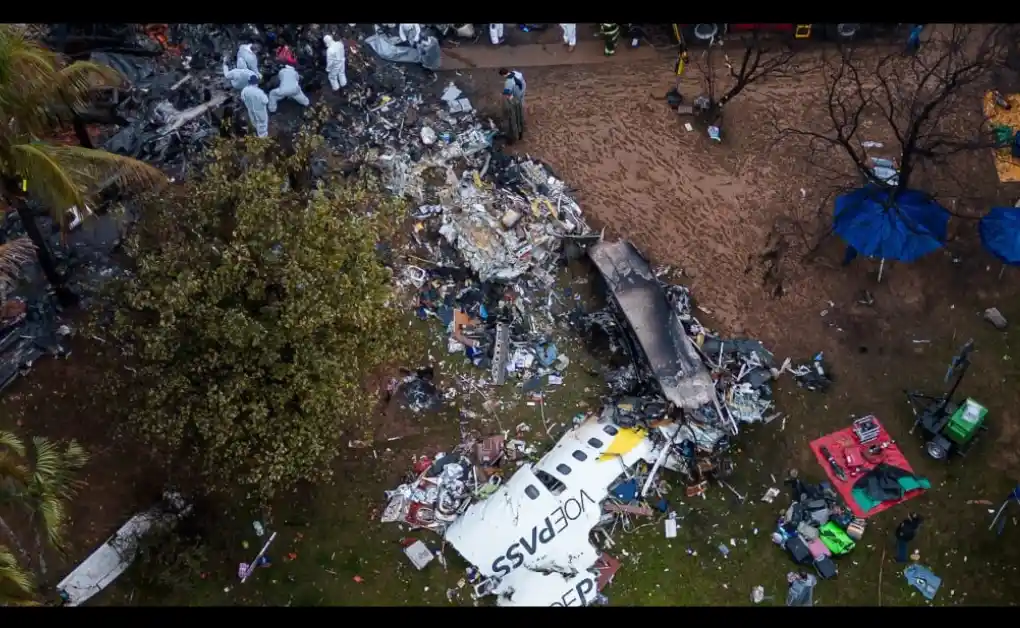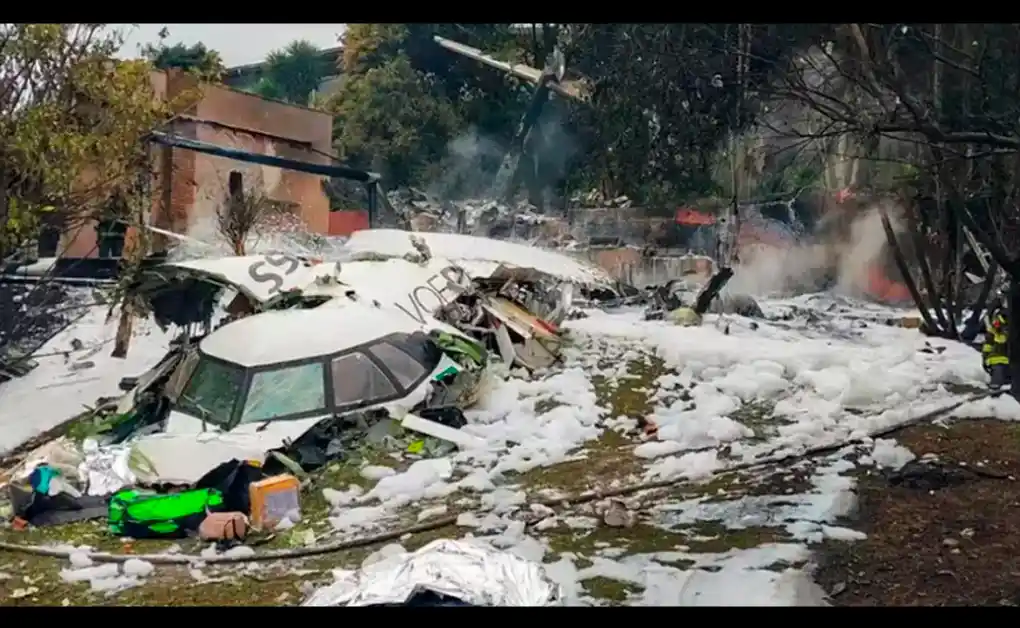The tragic Brazil plane crash that claimed the lives of all 62 passengers and crew members last month is believed to be linked to problems with the aircraft’s de-icing system. According to a preliminary report released on Friday, ice buildup on the wings and potential malfunctions in the de-icing system could have contributed to the accident. While these findings are significant, investigators have stopped short of confirming them as the definitive cause of the crash.

Details of the Plane Crash in Brazil
The plane crash in Brazil occurred on August 9, when an ATR 72 twin-engine turboprop operated by Voepass Airlines went down in the city of Vinhedo. The aircraft was en route from Cascavel, Paraná, to São Paulo’s Guarulhos International Airport when it crashed about 80 kilometers (50 miles) northwest of São Paulo. The Sao Paulo plane crash was particularly shocking, as footage captured the plane spinning flat before impacting the ground in a gated community’s backyard. It has since been recognized as the deadliest Brazilian plane crash since January 2023.
Preliminary Findings: Ice Buildup and De-Icing Issues
The preliminary investigation suggests that ice accumulation on the aircraft’s wings was a significant factor in the plane crash Brazil. Audio from the cockpit revealed that the pilots were aware of the icing threat, with the copilot stating, “A lot of ice,” just two minutes before the crash. Data from the plane’s systems showed that the de-icing system was activated and deactivated multiple times throughout the flight, indicating the crew’s attempts to use it. However, it is still uncertain whether the system functioned as intended.
Paulo Fróes, an investigator with Brazil’s air force’s Center for the Investigation and Prevention of Air Accidents (Cenipa), noted that there were irregularities in the de-icing system’s performance during the flight. While the accumulation of ice likely played a critical role in the Brazil plane crash, Fróes emphasized that further analysis is necessary to confirm the cause.
The Role of Icing in the Brazil Plane Crash
Weather reports for the day of the Brazil aircrash indicated conditions that were conducive to ice formation in the region where the plane was flying. Ice buildup on the wings can severely impair an aircraft’s ability to generate lift, increasing the likelihood of a loss of control. Although the preliminary report does not definitively blame ice for the plane crash Brazil airline incident, it strongly indicates that it was a major contributing factor.
Carlos Henrique Baldin, who leads Cenipa’s investigation division, expressed that given the plane’s safety features, such an accident should not have occurred. “It had protection equipment,” Baldin said. “Yet the accident happened, indicating there were complications beyond the expected risks.”
Manual De-Icing System Raises Concerns
The ATR 72 involved in the Brazil plane crash features a manually controlled de-icing system, which requires pilots to activate it when needed. Henrique Hacklaender, president of the National Aviators’ Union, noted that the system was engaged during the flight, indicating that the pilots were aware of the icing problem. However, it remains unclear whether the de-icing system was sufficient to handle the ice formation that occurred.
Ongoing Investigation into the Brazilian Plane Crash
The investigation into the Brazilian plane crash is ongoing, with Cenipa working alongside the Federal Police to identify any potential liabilities. There is no set timeline for the investigation’s conclusion, as more data is needed to fully understand why the de-icing system did not effectively prevent the ice accumulation or why the crew was unable to manage the situation. Investigators continue to analyze the aircraft’s voice and flight data recorders to gather more information.

ATR 72’s Safety Record and History of Ice-Related Crashes
The ATR 72 aircraft, which was involved in the Sao Paulo plane crash, is a widely used model for regional flights. Manufactured by a joint venture between Airbus and Leonardo S.p.A., the ATR 72 has faced previous incidents related to icing. The Brazil aircrash is not the first time this aircraft type has been linked to fatal accidents under icy conditions.
In January 2023, another ATR 72 operated by Yeti Airlines crashed in Nepal, resulting in the deaths of all 72 people on board. The final report on that incident attributed the crash primarily to pilot error. In 1994, an American Eagle ATR 72-200 also faced ice-related issues, leading to a crash that killed all 68 passengers. Following that tragedy, the U.S. Federal Aviation Administration (FAA) issued guidelines advising pilots of ATR models to avoid using autopilot during icing conditions.
Significance of the De-Icing System in Preventing Aircrash Brazil
The de-icing system is crucial for aircraft operating in cold or high-altitude regions, as it prevents ice from forming on key surfaces like the wings. In the plane crash Brazil, the preliminary report suggests that the de-icing system may have been activated but was not able to fully address the amount of ice forming on the plane. This raises questions about the system’s effectiveness and the procedures used by pilots when flying in icy conditions.
What’s Next in the Investigation?
Authorities are continuing to investigate the Brazil aircrash to determine the precise cause. The data from the cockpit voice recorder and flight data recorder will undergo further analysis to clarify why the de-icing system failed to prevent the buildup of ice or why the crew was unable to regain control of the aircraft. While investigators are cautious about drawing final conclusions, the focus remains on enhancing safety measures and potentially updating training procedures for pilots who operate in regions prone to icing.
Impact on Aviation Safety in Brazil
The plane crash in Brazil has prompted renewed discussions about aviation safety, both within the country and internationally. Brazil’s aviation authorities and airlines are expected to review their policies for flying under adverse weather conditions, particularly with respect to icing risks. This incident serves as a stark reminder of the importance of thorough pilot training and the need for all safety equipment, such as de-icing systems, to be properly maintained and fully functional.
Conclusion: Ice Likely a Major Factor in Brazil Plane Crash
While the investigation into the Sao Paulo plane crash is still ongoing, initial findings strongly suggest that ice accumulation and potential malfunctions in the de-icing system played a significant role. The Brazil plane crash, which claimed the lives of 62 people, has highlighted the critical importance of effective de-icing procedures and greater awareness of weather-related risks in aviation. Similarly, the recent Osprey crash near Japan underscores the need for stringent safety protocols and proactive measures to address mechanical issues and adverse conditions. The final report will likely provide additional insights and recommendations aimed at preventing similar tragedies in the future. In the meantime, aviation authorities are taking the preliminary findings seriously and are working to improve safety standards and pilot training for flights that may encounter icy conditions.
FAQs
What caused the Brazil plane crash?
The preliminary investigation suggests that ice accumulation on the wings and possible issues with the de-icing system contributed to the crash, though a final conclusion has not been reached.
How did cockpit audio contribute to the investigation?
The cockpit audio revealed that the pilots were aware of the ice buildup, with the copilot mentioning “a lot of ice” just two minutes before the crash.
Have there been other incidents involving the ATR 72 and ice?
Yes, the ATR 72 has a history of accidents related to icing, including the 1994 American Eagle crash and the 2023 Yeti Airlines crash in Nepal.
What steps are being taken to prevent future plane crash incidents in Brazil?
Authorities are reviewing safety procedures, pilot training, and the effectiveness of de-icing systems to prevent future accidents involving ice accumulation.
Why is the de-icing system important for aircraft?
De-icing systems prevent ice from forming on critical surfaces like wings, ensuring that the aircraft maintains proper lift and control during flight.